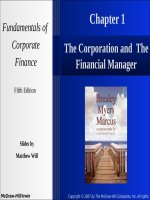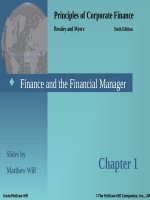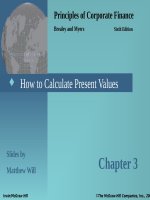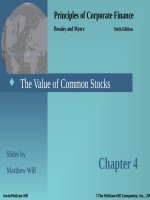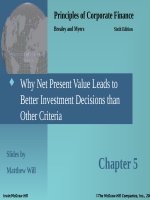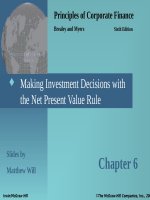Principles of cororate finance 6th brealey myers chapter 04
Bạn đang xem bản rút gọn của tài liệu. Xem và tải ngay bản đầy đủ của tài liệu tại đây (345.54 KB, 32 trang )
Principles of Corporate Finance
Brealey and Myers
Sixth Edition
The Value of Common Stocks
Slides by
Matthew Will
Irwin/McGraw Hill
Chapter 4
©The McGraw-Hill Companies, Inc., 200
4- 2
Topics Covered
How To Value Common Stock
Capitalization Rates
Stock Prices and EPS
Cash Flows and the Value of a Business
Irwin/McGraw Hill
©The McGraw-Hill Companies, Inc., 200
4- 3
Stocks & Stock Market
Common Stock - Ownership shares in a publicly held
corporation.
Secondary Market - market in which already issued
securities are traded by investors.
Dividend - Periodic cash distribution from the firm to
the shareholders.
P/E Ratio - Price per share divided by earnings per
share.
Irwin/McGraw Hill
©The McGraw-Hill Companies, Inc., 200
4- 4
Stocks & Stock Market
Book Value - Net worth of the firm according to the
balance sheet.
Liquidation Value - Net proceeds that would be
realized by selling the firm’s assets and paying off
its creditors.
Market Value Balance Sheet - Financial statement
that uses market value of assets and liabilities.
Irwin/McGraw Hill
©The McGraw-Hill Companies, Inc., 200
4- 5
Valuing Common Stocks
Expected Return - The percentage yield that an
investor forecasts from a specific investment over a
set period of time. Sometimes called the market
capitalization rate.
Irwin/McGraw Hill
©The McGraw-Hill Companies, Inc., 200
4- 6
Valuing Common Stocks
Expected Return - The percentage yield that an
investor forecasts from a specific investment over a
set period of time. Sometimes called the market
capitalization rate.
Div1 + P1 − P0
Expected Return = r =
P0
Irwin/McGraw Hill
©The McGraw-Hill Companies, Inc., 200
4- 7
Valuing Common Stocks
The formula can be broken into two parts.
Dividend Yield + Capital Appreciation
Irwin/McGraw Hill
©The McGraw-Hill Companies, Inc., 200
4- 8
Valuing Common Stocks
The formula can be broken into two parts.
Dividend Yield + Capital Appreciation
Div1 P1 − P0
Expected Return = r =
+
P0
P0
Irwin/McGraw Hill
©The McGraw-Hill Companies, Inc., 200
4- 9
Valuing Common Stocks
Capitalization Rate can be estimated using the
perpetuity formula, given minor algebraic
manipulation.
Irwin/McGraw Hill
©The McGraw-Hill Companies, Inc., 200
4- 10
Valuing Common Stocks
Capitalization Rate can be estimated using the
perpetuity formula, given minor algebraic
manipulation.
Div1
Capitalization Rate = P0 =
r−g
Div1
=r=
+g
P0
Irwin/McGraw Hill
©The McGraw-Hill Companies, Inc., 200
4- 11
Valuing Common Stocks
Return Measurements
Div1
Dividend Yield =
P0
Return on Equity = ROE
EPS
ROE =
Book Equity Per Share
Irwin/McGraw Hill
©The McGraw-Hill Companies, Inc., 200
4- 12
Valuing Common Stocks
Dividend Discount Model - Computation of today’s
stock price which states that share value equals the
present value of all expected future dividends.
Irwin/McGraw Hill
©The McGraw-Hill Companies, Inc., 200
4- 13
Valuing Common Stocks
Dividend Discount Model - Computation of today’s
stock price which states that share value equals the
present value of all expected future dividends.
Div1
Div2
Div H + PH
P0 =
+
+...+
1
2
H
(1 + r ) (1 + r )
(1 + r )
H - Time horizon for your investment.
Irwin/McGraw Hill
©The McGraw-Hill Companies, Inc., 200
4- 14
Valuing Common Stocks
Example
Current forecasts are for XYZ Company to pay
dividends of $3, $3.24, and $3.50 over the next
three years, respectively. At the end of three years
you anticipate selling your stock at a market price
of $94.48. What is the price of the stock given a
12% expected return?
Irwin/McGraw Hill
©The McGraw-Hill Companies, Inc., 200
4- 15
Valuing Common Stocks
Example
Current forecasts are for XYZ Company to pay dividends of $3, $3.24,
and $3.50 over the next three years, respectively. At the end of three
years you anticipate selling your stock at a market price of $94.48.
What is the price of the stock given a 12% expected return?
3.00
3.24
350
. + 94.48
PV =
+
+
1
2
3
(1+.12) (1+.12)
(1+.12)
PV = $75.00
Irwin/McGraw Hill
©The McGraw-Hill Companies, Inc., 200
4- 16
Valuing Common Stocks
If we forecast no growth, and plan to hold out
stock indefinitely, we will then value the stock as a
PERPETUITY.
Irwin/McGraw Hill
©The McGraw-Hill Companies, Inc., 200
4- 17
Valuing Common Stocks
If we forecast no growth, and plan to hold out
stock indefinitely, we will then value the stock as a
PERPETUITY.
Div1
EPS1
Perpetuity = P0 =
or
r
r
Assumes all earnings are
paid to shareholders.
Irwin/McGraw Hill
©The McGraw-Hill Companies, Inc., 200
4- 18
Valuing Common Stocks
Constant Growth DDM - A version of the dividend
growth model in which dividends grow at a
constant rate (Gordon Growth Model).
Irwin/McGraw Hill
©The McGraw-Hill Companies, Inc., 200
4- 19
Valuing Common Stocks
Example- continued
If the same stock is selling for $100 in the stock
market, what might the market be assuming about
the growth in dividends?
$3.00
$100 =
.12 − g
g =.09
Irwin/McGraw Hill
Answer
The market is
assuming the dividend
will grow at 9% per
year, indefinitely.
©The McGraw-Hill Companies, Inc., 200
4- 20
Valuing Common Stocks
If a firm elects to pay a lower dividend, and
reinvest the funds, the stock price may increase
because future dividends may be higher.
Payout Ratio - Fraction of earnings paid out as
dividends
Plowback Ratio - Fraction of earnings retained by
the firm.
Irwin/McGraw Hill
©The McGraw-Hill Companies, Inc., 200
4- 21
Valuing Common Stocks
Growth can be derived from applying the return on
equity to the percentage of earnings plowed back
into operations.
g = return on equity X plowback ratio
Irwin/McGraw Hill
©The McGraw-Hill Companies, Inc., 200
4- 22
Valuing Common Stocks
Example
Our company forecasts to pay a $5.00
dividend next year, which represents
100% of its earnings. This will
provide investors with a 12% expected
return. Instead, we decide to plow
back 40% of the earnings at the firm’s
current return on equity of 20%. What
is the value of the stock before and
after the plowback decision?
Irwin/McGraw Hill
©The McGraw-Hill Companies, Inc., 200
4- 23
Valuing Common Stocks
Example
Our company forecasts to pay a $5.00 dividend next year, which
represents 100% of its earnings. This will provide investors with a 12%
expected return. Instead, we decide to blow back 40% of the earnings
at the firm’s current return on equity of 20%. What is the value of the
stock before and after the plowback decision?
No Growth
With Growth
5
P0 =
= $41.67
.12
Irwin/McGraw Hill
©The McGraw-Hill Companies, Inc., 200
4- 24
Valuing Common Stocks
Example
Our company forecasts to pay a $5.00 dividend next year, which
represents 100% of its earnings. This will provide investors with a 12%
expected return. Instead, we decide to blow back 40% of the earnings
at the firm’s current return on equity of 20%. What is the value of the
stock before and after the plowback decision?
No Growth
5
P0 =
= $41.67
.12
Irwin/McGraw Hill
With Growth
g =.20×.40 =.08
3
P0 =
= $75.00
.12 −.08
©The McGraw-Hill Companies, Inc., 200
4- 25
Valuing Common Stocks
Example - continued
If the company did not plowback some earnings,
the stock price would remain at $41.67. With the
plowback, the price rose to $75.00.
The difference between these two numbers (75.0041.67=33.33) is called the Present Value of Growth
Opportunities (PVGO).
Irwin/McGraw Hill
©The McGraw-Hill Companies, Inc., 200



